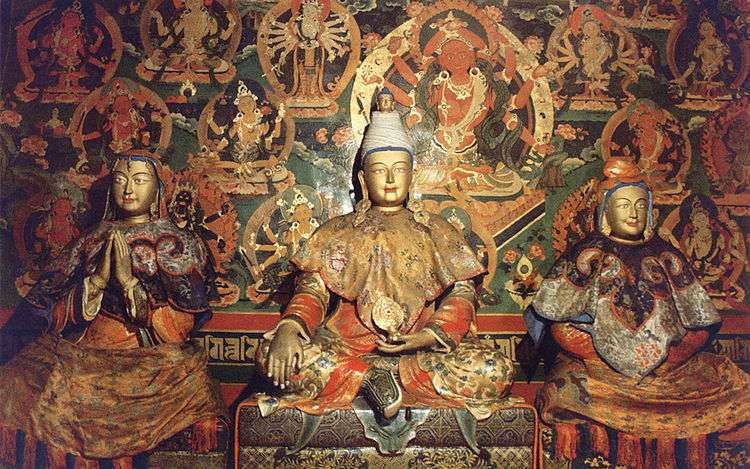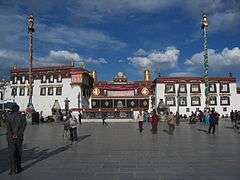Princess Wencheng
| Wencheng | |||||
|---|---|---|---|---|---|
 | |||||
| Born | 628 | ||||
| Died | 680 or 682 | ||||
| Songtsen Gampo | |||||
| |||||
Princess Wencheng (Tibetan: Mung-chang Kungco; Chinese: 文成公主; pinyin: Wénchéng Gōngzhǔ; Wade–Giles: Wen-ch'eng Kung-chu; 628–680/2[1]), surnamed Li, was a member of a minor branch of the royal clan of the Chinese Tang dynasty (possibly the daughter of Li Daozong, the Prince of Jiangxia). In 641,[1] she was granted by Emperor Taizong of Tang to King Songtsen Gampo of Tibet for marriage, an involuntary actor of the emperor's heqin (marriage alliance) policy.[2] She is popularly known in Tibet as Gyasa, or "Chinese wife".[3]
Much of her life has been mythified and used for propaganda purposes. Chinese sources since the Tang dynasty credit her with introducing Chinese culture to Tibet,[4] whereas Tibetan sources credit her, along with Songtsen Gampo's Nepalese wife, Bhrikuti, with introducing Buddhism to Tibet.[5][6] Traditional Tibetan histories consider both Wencheng and Bhrikuti as physical manifestations of the bodhisattva Tara,[7] although the historical veracity of Bhrikuti is still debated among scholars.[1][8]
Prelude to the marriage
Chinese records mention receiving envoys and tributes in 634 from Songtsen Gampo wherein the king requested (Tibetan sources say demanded)[9] to marry a Chinese princess and was refused. In 635/636 the Tibetan king's forces attacked and defeated the Tuyuhun, who lived around Lake Koko Nor in present-day Qinghai, along an important trade route into China. Songtsen Gampo attacked the Chinese frontier city of Songzhou (OTA l. 607) – Chinese sources say a Tang force defeated his army and he retreated and sent an apology to the Tang emperor. Taizong then agreed (using threat of force, according to Tibetan histories) to marry a Chinese princess to the Tibetan king.[9]
Cultural importance
Songtsen Gampo and Princess Wencheng married in hopes of promoting harmonious, matrimonial relationships between Tibet and China.[10] It is widely believed that his marriages of states to Bhrikuti and Wencheng brought sacred images of Gautama Buddha and Buddhism in general to Tibet, and further, that their complicated relationship as co-wives led to the construction of the Jokhang, whereupon the city of Lhasa. Because the stories of her matrimonial journey are evolving and ever increasing, it is difficult to identify fiction from historical reality. These stories are included in such medieval romances as the Maṇi bka' 'bum and historiographies such as the Rgyal rabs Gsal ba'i Me long.
In addition to the Chinese culture and Buddhism, Wencheng brought with her promises of trade agreements and safe passage on the Silk Road and a substantial amount of dowry which contained not only gold, but fine furniture, silks, porcelains, books, jewelry, musical instruments, and medical books.[10] Additionally and more importantly, Wencheng arrived with new agricultural methods. This included the introduction of seeds of grains and rapeseed, other farming tools and advice on how to increase Tibetan agricultural productivity. Wencheng was also credited for introducing Tibet with other skills in metallurgy, farming, weaving, construction,manufacture of paper and ink as well as developing the Tibetan alphabet and writing system.[10]
Chinese sources credit Wencheng with bringing Chinese culture to Tibet, but this is not corroborated by Tibetan sources.[11] Tibetans believe that it was Songtsen Gampo who promoted Tibet's technical and social progress by establishing his capital at Lhasa and building the powerful Tibetan Empire, and whose main building strategy was purposely to seek ways to introduce new cultures into his kingdom.[10]
According to Chinese sources, Wencheng was revered for being one of the diplomat brides who brought much needed positive Han Chinese culture to the peoples beyond their borders - expanding their knowledge - whom the imperial court often looked down upon as barbaric.[10]
Tradruk Temple in Nêdong is also connected with Wencheng: a thangka embroidered by Wencheng is kept in one of its chapels.
Wencheng's legacy and influence lives on. Generations of poets continue to write countless verses to praise her doings. Two traditional days, the fifteenth day of the fourth month and the fifteenth day of the tenth month of each Tibetan year, are marked by singing and dancing in her honor. Historic relics such as the statues of Songtsen Gampo with Princess Wencheng are still worshiped and displayed for all to see along the trail of their wedding trip as well as in the Potala Palace at Lhasa.[12]
Footnotes
- 1 2 3 Warner (2011), p. 6.
- ↑ Slobodník (2006), p. 268.
- ↑ Dowman (1988), p. 41.
- ↑ Powers (2004), p. 32.
- ↑ Laird (2007), p. 35.
- ↑ Powers (2004), p. 35.
- ↑ Powers (2004), p. 36.
- ↑ Powers (2004), p. 170.
- 1 2 Powers (2004), p. 168.
- 1 2 3 4 5 "The Marriage of Wencheng", Women in World History Curriculum.
- ↑ Powers (2004), p. 30-38.
- ↑ Jay (2014), p. 205.
References and further reading
- Beckwith, Christopher I. (1987). The Tibetan Empire in Central Asia. Princeton: Princeton University Press.
- Dowman, Keith (1988). The Power-places of Central Tibet: The Pilgrim's Guide. London and New York: Routledge & Kegan Paul. ISBN 0-7102-1370-0.
- Jay, Jennifer W. (2014). "Li, Princess Wencheng". In Lee, Lily Xiao Hong; Wiles, Sue. Biographical Dictionary of Chinese Women: Tang Through Ming, 618–1644. M.E. Sharpe. pp. 204–205. ISBN 978-0-7656-4316-2.
- Laird, Thomas (2007). The Story of Tibet: Conversations with the Dalai Lama. Grove Press. ISBN 978-0-8021-4327-3.
- Peterson, Barbara Bennett (2000). Notable Women of China. M.E. Sharpe. ISBN 978-0-7656-1929-7.
- Powers, John (2004). History As Propaganda : Tibetan Exiles versus the People's Republic of China: Tibetan Exiles versus the People's Republic of China. Oxford University Press. ISBN 978-0-19-803884-9.
- Richardson, Hugh E. (1965). "How Old was Srong Brtsan Sgampo" (PDF). Bulletin of Tibetology. 1 (2): 5–9.
- —— (1997). "Mun Sheng Kong Co and Kim Sheng Kong Co: Two Chinese Princesses in Tibet". The Tibet Journal. 22 (1): 3–11.
- Slobodník, Martin (2006). "The Chinese Princess Wencheng in Tibet: A Cultural Intermediary between Facts and Myth". In Gálik, M.; Štefanovičová, T. Trade, Journeys, Inner- and Intercultural Communication in East and West (up to 1250). Bratislava: Lufema. pp. 267–276.
- Warner, Cameron David (2011). "A Prolegomenon to the Palladium of Tibet, the Jowo (Jo bo) Śākyamuni". In Bue, Erberto Lo. Proceedings of the Tenth Seminar of the IATS, 2003. Volume 13: Art in Tibet: Issues in Traditional Tibetan Art from the Seventh to the Twentieth Century. BRILL. pp. 3–17. ISBN 90-04-15519-8.

